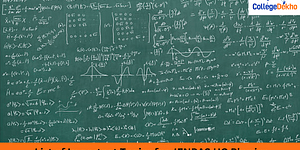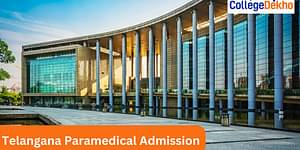DMLT Syllabus & Subjects 2024
DMLT Syllabus is divided into 4 semesters that are taught over the 2-year course duration. Some of the core topics under the DMLT Syllabus are Information and Communication Technology, Metabolic and Technical Biochemistry, Clinical Biochemistry, Clinical Pathology, Human Anatomy & Physiology, and Technical Microbiology, among others.
DMLT Syllabus & Subjects Overview
DMLT Syllabus is designed keeping in mind the important aspects of the Medical Laboratory Technology, to prepare students with the skill sets and knowledge of medical facilities for assistance in the field of Medical Sciences. Some of the important DMLT subjects integrated in the DMLT Syllabus are Basic Concepts of MLT, Information and Communication Technology, Metabolic and Technical Biochemistry, Clinical Biochemistry, Clinical Pathology, Human Anatomy & Physiology, Technical Microbiology and much more. The DMLT Course is a 2-year-long degree program in the field of paramedical sciences, highlighting the medical techniques and methods to test, analyze, interpret and report the results effectively and efficiently. DMLT Admission is conducted majorly through entrance examination.
The DMLT syllabus and subject aims to provide the necessary knowledge and training to carry out such crucial tasks. The DMLT syllabus is divided into a 2-year structure, each year comprising two semesters. The important DMLT subjects are equally categorized into each semester, providing a holistic learning experience for the students. The entrance exam DMLT syllabus includes four subjects, namely, Physics, Chemistry, Biology and Mathematics. Moreover, the DMLT syllabus and subjects also aid in helping students to secure DMLT Jobs with decent DMLT Salary across hospitals, pathology laboratories and other medical testing centres. The different aspects of the DMLT Syllabus and important DMLT subjects across top colleges in India are mentioned below for reference.
Table of Contents
Semester-wise DMLT Syllabus
DMLT Syllabus is crafted to meet the objectives and the needs of the students’ Learning experience. DMLT Syllabus covers both practical and theoretical subjects, throwing focus mainly on laboratory technologies. The semester-wise DMLT course syllabus is mentioned below for students to refer to:
1st Year DMLT Syllabus
The table below contains the DMLT subjects in the first year:
| Semester I | Semester II |
|---|---|
| Human Anatomy | Human Pathology |
| Fundamentals of MLT | Basic pathology |
| Basics of Clinical Biochemistry | Fundamental Biochemistry |
| Basic Human Science | Microbial Instrumentation |
| English Communication | Information and Communication Technology |
| Professional Activities | Community Development |
2nd Year DMLT Syllabus
The table below contains the DMLT subjects in the second year:
| Semester III | Semester IV |
|---|---|
| Human Physiology | Histopathological Techniques |
| Clinical Hematology | Clinical Biochemistry |
| Metabolic and Technical Biochemistry | Clinical Microbiology |
| Technical Microbiology | Clinical Pathology |
| Community Development Activities II | Pathology Lab |
List of DMLT Subjects
DMLT subjects are divided into two categories: cord and elective subjects. The DMLT Syllabus curriculum is designed with elective and core-based subjects to make the two-year diploma program flexible for the students. DMLT Syllabus includes theoretical teaching methodology, which trains students to enhance their overall knowledge and deep understanding. Mentioned below are the list of DMLT Subjects for students to refer to:
DMLT Core Subjects
Below is the list of DMLT core subjects:
- Human Anatomy
- Fundamentals of MLT
- Human Physiology
- Fundamental Biochemistry
DMLT Elective Subjects
Below is the list of DMLT elective subjects:
- Clinical Hematology
- Technical Microbiology
- Clinical Microbiology
- Clinical Biochemistry
Year-wise DMLT Syllabus
Each university and college offering the course will define the exact DMLT year-wise syllabus that students will be asked to complete. However, there are a few subjects and topics taught across India. Listed below are some of these year-wise DMLT course syllabus and subjects, aspirants can expect to be taught at their desired universities.
1st Year DMLT Syllabus
The table below outlines some of the common DMLT 1st year syllabus, taught across different universities and colleges.
| Subjects | Topics |
|---|---|
| Human Anatomy and Physiology | From studying the cell structure to understanding the central nervous system, and much more, Human Anatomy and Physiology are subjects that are taught across all universities and colleges offering a DMLT course. |
| Pathology | The subject will cover topics related to haematology, clinical pathology, blood banking and parasitology among others. |
| Fundamentals of MLT | The subject will mainly focus on different topics related to the laboratory, viz, an overview/introduction to medical lab technology and various services, the glassware and equipment used as well as the safety & maintenance of the laboratories, among others. |
| Information and Communication Technology | The subject primarily focuses on preparing students with the necessary computer skills, particularly in software and hardware used in the medical lab tech fields. |
2nd Year DMLT Syllabus
Universities offering the course may include the following DMLT 2nd year syllabus, as listed in the table below:
| Subjects | Topics |
|---|---|
| Histopathology | The subject will include topics such as the different histopathological techniques, tissue processing and embedding, mounting and staining and much more. |
| Biochemistry | Varying from university to university, the subject will delve deep into topics like Biochemistrical structure, Clinical Biochemistry, Estimation of tests of different enzymes, sugar, etc. |
| Microbiology | The subject will cover various topics ranging from sterilisation, bacterial culture, systemic bacteriology and much more. |
| Coagulation and Transfusion Medicine | The subject will train students in understanding and investigating coagulation disorders while also understanding the principles of immunohematology. |
Each university will be offering a unique blend of topics and subjects for DMLT, which will prepare them for jobs and further education in the field of Medical Lab Technology.
Entrance Exam DMLT Syllabus
Interested students may refer to the list of important DMLT Subjects and DMLT topics mentioned below in the table to derive an idea of the entrance exam DMLT Syllabus:
| DMLT Subjects | DMLT Topics |
|---|---|
Biology | Plant Anatomy |
| Plant Physiology | |
| Cell Biology and Genetics | |
| Biotechnology | |
| Biology in Human welfare | |
| Human Physiology | |
| Environmental Science | |
| Evolution | |
| Modern Genetics and Animal Biotechnology | |
| Immunology | |
| Microbiology | |
Physics | Units and Measurement |
| Electricity and Magnetism | |
| Gravitation, Mechanics of Solids and Fluids | |
| Dual Nature of Matter and Nuclear Physics | |
| Heat and Thermodynamics | |
| Mechanics | |
| Oscillations and Wave Motion | |
| Atomic Physics and Relativity | |
| Electronics and Communication | |
| Ray and wave Optics and Magnetism | |
Mathematics | Matrices, Determinants & their applications |
| Sets, Relations, and Functions | |
| Algebra | |
| Complex Numbers and Quadratic equations | |
| Differential Calculus | |
| Statistics and Probability | |
| Integral Calculus & Differential Equations of first order | |
| Analytical Geometry | |
Chemistry | Atomic structure |
| Chemical Bonding, Molecular Structure, and s-& p- block elements | |
| States of Matter | |
| Chemical Equilibrium | |
| Hydrocarbons | |
| Solutions | |
| Chemical Thermodynamics & Energetics | |
| Purification & Characterization of organic compounds | |
| Organic Chemistry | |
| Surface Chemistry, Chemical Kinetics, Catalysis and Nuclear Chemistry | |
| Organic Compounds Containing Oxygen | |
| Polymers | |
| Biomolecules |
DMLT Important Books
A way to enhance the knowledge and understanding of the field is to use references and guidebooks. These books will help students understand the different techniques and methodologies that have been in use in the field of medical lab technology. Some of the books recommended by faculties include:
- Clinical Microbiology and parasitology by Nanda Maheshwari
- Biochemistry for DMLT by Arya Bhusan and Arun Jyoti
- Clinical Pathology by Dr J.S.Chauhan
- Practical Human Anatomy and Physiology by Mr Mahaveer P.Kabra and Mr Atul Kabra
While these are some of the more recommended books, the faculty at the college or university a student has been enrolled in will also suggest additional books and guides that must also be used.
DMLT Course Structure
While the overall course structure is defined by the government medical education body, universities and colleges have the authority to determine the course structure as well. However, the commonly followed course structure for the DMLT syllabus has been outlined in the table below.
| Duration | 2 Years |
|---|---|
| Learning Methodologies | Seminars, Traditional Classroom education, Group Projects, Clinical Training and university-specific individual learning methodologies may be employed throughout the course. |
| Course Projects | Each university will define the project submission requirements, however, students will be asked to submit at least one project throughout the two-year diploma course. |
| Course Structure | 4 semesters of core and elective subjects and topics along with laboratory sessions and project submissions. |
| Assessment | Semester-wise examination along with practice tests and projects. |
Note: While the course structure for DMLT will be similar across all universities and colleges offering the course, each college can and will add different courses, and practical sessions or adopt different teaching methodologies for the course.
DMLT Syllabus: Teaching Methodology
DMLT course syllabus suggests a specific set teaching methodologies, to be followed in the medical field with the development of technology. With the growing interest in digital learning and hands-on experience with hospital and laboratory equipment, DMLT Syllabus has incorporated the new-age learning experience through advanced teaching methodologies and techniques. Listed below are some of the teaching methodologies that DMLT Syllabus suggests in general:
- Seminars
- Group Projects
- Digital Learning
- Traditional Classroom-based teaching
- Practical Lab sessions
- Self Directed Learning
DMLT Syllabus Projects
DMLT course projects are given to the students for developing critical knowledge and skills for their college and career growth. Projects for DMLT courses give students hands-on experience and fieldwork for their future development. The project is to be completed by the end of the fourth semester. Some popular DMLT course projects are:
- Benefits of the Procalcitonin as a Diagnostic Biomarker in Rush’s Core Laboratory
- The Role of Store-Operated Channels in Inflammatory Cytokine Production in the Genetically Inherited Dermatosis Disease
- Validation of Heparin-Induced Thrombocytopenia (HIT) Assay on an Automated Platform at Northwestern Hospital
- Comprehensive Exam and Its Correlation with Board Certification Scores in Medical Laboratory Science Program at Rush University
- The Role of Hyperglycemia in CD4 T Cell Death
FAQs about DMLT Course Syllabus
How to Prepare DMLT Syllabus?
Students can prepare for DMLT Syllabus by going through the detailed DMLT Syllabus structure, understanding the core and elective subjects, dedicating adequate time to focus on each DMLT Subject topics, and practice solving questions.
Is DMLT Syllabus Tough?
No, DMLT Syllabus is not difficult. However, students are required to adopt a proper learning technique in order to gain a deeper understanding of the DMLT Course Syllabus.
Which books are recommended for DMLT 1st Year?
Books recommended for DMLT 1st Year are ‘Biochemistry for DMLT’ by Arya Bhusan, and Arun Jyoti and ‘Practical Human Anatomy and Physiology’ by Mr Mahaveer P. Kabra and Mr Atul Kabra
What are DMLT 1st Year Subjects?
DMLT 1st Year Subjects include Human Anatomy, Human Pathology, Basic pathology, Biochemistry, Microbial Instrumentation, Information and Communication Technology, etc.














